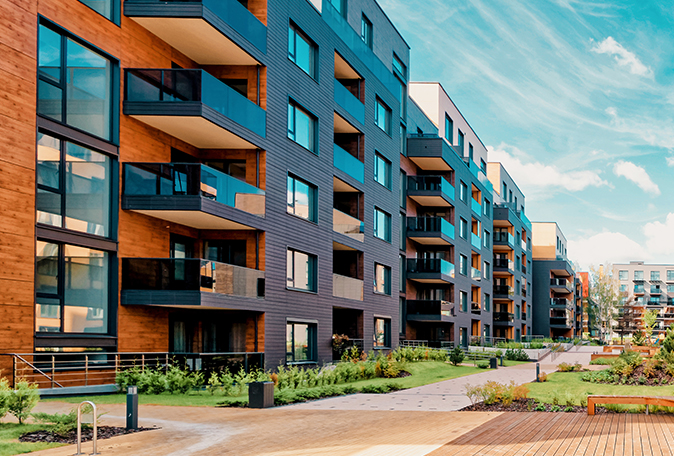Multifamily communities (particularly intentional communities) often offer enhanced social connectivity, reduced costs, shared resources, and a lower carbon footprint, making them a sustainable living choice.
Intentional and multifamily communities are a paradigm shift from the conventional single-family housing model. These communities offer a plethora of benefits for residents while addressing our shared responsibility to the environment. By design, they utilize resources more efficiently, which translates to lower utility costs and a reduced carbon footprint. Shared amenities and smaller living spaces cut down on waste and energy use, aligning with the tenets of sustainable living.
Furthermore, these communities foster a strong sense of camaraderie and shared purpose. Residents often have access to communal spaces for socializing, gardening, and other shared activities, enhancing social interaction and mental well-being. For those seeking affordability, such setups offer shared costs and cooperative ownership models. In essence, intentional and multifamily communities offer an appealing blend of economic, environmental, and social benefits – a compelling alternative for individuals committed to sustainability, community, and conscientious living.
Key Concepts:
1Sustainable Living
Intentional and multifamily communities prioritize environmental stewardship. They commonly integrate renewable energy systems, water conservation measures, and waste reduction strategies into their design. For example, shared solar power systems and community composting facilities can significantly decrease a community’s ecological footprint. Many also encourage the use of sustainable transportation, like biking and carpooling, further minimizing carbon emissions. These communities prioritize sustainable practices, such as renewable energy, water conservation, and waste reduction. They incorporate shared solar panels, rainwater harvesting, and composting facilities, minimizing their ecological footprint.
Fact: A study found that residents in cohousing communities use 30-40% less energy than their counterparts in conventional housing.
- “Pocket Neighborhoods: Creating Small-Scale Community in a Large-Scale World” by Ross Chapin, Sarah Susanka.
2Shared Resources
Sharing resources is a defining feature of these communities. Shared spaces, such as kitchens, living areas, and laundry facilities, not only reduce the per-person cost of building and maintaining these amenities but also decrease the total resource consumption of the community. Shared resources reduce construction and maintenance costs. By sharing facilities such as kitchens, living areas, and laundry rooms, residents not only save money but also decrease their environmental impact.
Fact: Shared amenities in a multifamily building can save up to 25% of construction costs, compared to individual homes.

3Social Connectivity
Multifamily and intentional communities foster a deep sense of community. They often incorporate shared meal times, community activities, and participatory decision-making processes, encouraging interaction and mutual support among residents. This not only contributes to individual wellbeing but also to the resilience of the community as a whole. Strong community bonds are nurtured through shared activities and collaborative decision-making. The sense of belonging enhances mental health and wellbeing.
Fact: A survey of cohousing communities found that over 80% of residents report higher levels of social interaction and support compared to previous living arrangements.
4Affordability
By sharing resources, costs are significantly reduced. From shared Wi-Fi to shared maintenance expenses, the financial burden of living in such communities is often lower than conventional housing options. Moreover, this affordable housing approach aligns with social justice principles, providing quality housing for a wider range of income levels. The cost-sharing nature of these communities makes them more affordable than traditional housing options, catering to a broader range of income levels.
Fact: Residents of intentional communities typically save up to 20% on living expenses compared to conventional living arrangements.

5Health and Wellbeing
The design of these communities often promotes healthier lifestyles. They typically have ample green spaces for physical activities, and the sense of community can support mental health. Additionally, locally sourced food and shared meals contribute to healthier eating habits and food security. Green spaces for physical activity, strong community bonds, and access to fresh food all contribute to improved physical and mental health.
Fact: Community gardens in multifamily communities have been linked to increased physical activity, reduced stress, and improved diets.
6Resilience
Intentional and multifamily communities are often designed with resilience in mind. Shared resources, combined with strong social networks, allow these communities to better adapt to and recover from various challenges, including those posed by climate change. These communities are designed for resilience, with shared resources and strong social bonds that help them adapt to and recover from various challenges, including climate disruptions.
Fact: After Hurricane Sandy, cohousing communities in the impacted area recovered faster than traditional neighborhoods, thanks to their shared resources and strong social networks.

7Participatory Governance
Most intentional communities practice some form of participatory governance, allowing residents to have a direct say in the decisions affecting their community. This process empowers residents, fosters transparency, and promotes a sense of collective ownership and responsibility. Participatory decision-making fosters transparency and collective responsibility, giving residents direct control over their living conditions.
Fact: In a study of intentional communities, 95% of residents reported feeling more engaged in their community’s governance than in traditional neighborhoods.
8Localized Food Production
Many communities incorporate gardens, orchards, or even small farms into their designs. This approach not only decreases reliance on industrial agriculture and reduces food transportation emissions but also improves food security, nutritional value, and connection to nature. Many communities include community gardens or small farms, reducing reliance on industrial agriculture and improving food security.
Fact: Research shows that community gardens can produce the equivalent of up to $1,500 worth of produce per person annually.

9Diversity and Inclusion
Intentional communities aim to create inclusive environments, welcoming residents from various social, economic, and cultural backgrounds. This diversity enhances the richness of community life and aligns with social justice principles. These communities aim to welcome and value residents of diverse backgrounds, enriching the community’s social fabric.
Fact: Intentional communities tend to be more diverse than the U.S. average, with many specifically focusing on creating an inclusive environment.
10Education and Outreach
Many intentional and multifamily communities see themselves as models for sustainable living and actively engage in education and outreach activities. Residents often share their experiences and lessons learned with others, contributing to a broader societal shift toward sustainability. Many intentional communities actively engage in education and outreach, sharing their experiences and knowledge with wider audiences to promote sustainability.
Fact: : A survey found that 70% of intentional communities host workshops or educational events for the public, spreading the benefits of sustainable living beyond their borders.

Special Considerations for Affordable Housing Projects:
1Community Engagement
Involve future residents in the planning process. Their input on the design and operation of the community will ensure it meets their needs and fosters a sense of ownership, vital for the long-term success of the project.
2Sustainable Design
Integrating sustainable design principles will reduce operating costs and make living in the community more affordable. Consider measures like energy-efficient building design, renewable energy systems, and water conservation strategies.
3Shared Resources
Plan for shared facilities like kitchens, laundry rooms, and communal spaces. Shared resources reduce construction and maintenance costs, thereby contributing to the affordability of the housing project.
4Location
Choose a location with access to public transportation, schools, and amenities. This not only improves the quality of life but also reduces transportation-related costs and emissions.
5Inclusive Practices
Ensure the community is diverse and inclusive. This includes providing units that are accessible to people with disabilities and adopting fair housing practices. A diverse community enriches social interactions and fosters a sense of inclusivity.





